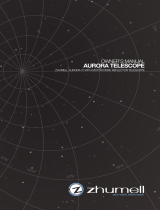
BEGINNING OBSERVATION
For beginning observation, the moon is one of the easiest and most enjoy-
able objects to view. You can acquaint yourself with the movements of the
telescope by simply pointing the telescope at the moon and using the various
adjustments to move the telescope.
To point the telescope at the moon, loosen the R.A. and Dec. clamps (the
thumbscrews located nearest the Hour Circle and Declination Circle on the
mount), then gently move the optical tube assembly until it points at the
moon. Retighten the R.A. and Dec. clamps before viewing.
While viewing, use the R.A. and Dec. adjustment cables to move the tele-
scope. Before using the R.A. cable, loosen the thumbscrew on the clock
drive to free the R.A. axis and prevent damage to the clock drive. The ad-
justment cables feature stops which allow a limited degree of adjustment. To
move past a stop, loosen the clamp for the axis you would like to move and
rotate the optical tube assembly past the stop. Be sure to retighten clamps
before viewing to provide a steady image.
If you notice resistance while moving the optical tube assembly, try adjusting
the counterweight position up or down to properly balance the telescope.
The optical tube assembly should move very easily. Do not force the optical
tube assembly, as you may cause damage to the telescope.
INTERMEDIATE OBSERVATION
Once you are familiar with the basic movements and adjustments of the tele-
scope, expand your exploration to other easy to find objects. Venus is one of
the easiest to find planets as it is one of the brightest objects in the night sky.
Local newspapers and planetariums are excellent resources for finding what
planets should be visible in your area on any given night. Other resources
are mentioned at the end of this manual.
To find a planet, look around the sky to locate the planet with your naked
eye first. Once you have located a planet, point the telescope at the planet.
Center the planet in the finderscope by using the crosshairs. Once the planet
is lined up in the finderscope, view the planet through the telescope using
the lowest power (longest focal length) eyepiece. You may need to make
slight adjustments to your aiming of the telescope and you will need to focus
your eyepiece to properly view the planet.
For a closer look at the planet, replace the low powered eyepiec with a higher
powered one and refocus the telescope.
The clock drive included with your telescope is designed to track the move-
ment of stars. It will help keep stars in your eld of view during long periods
of viewing as long as the telescope is properly polar aligned and the clock
drive is properly used. Do not be alarmed if you turn on the clock drive and
do not see the telescope moving. Stars appear to move very slowly and the
telescope may not apear to move over a short period of time. To see if your
clock drive is working, aim the telescope at a stationary terrestrial object
and engage the clock drive. Let the clock drive run for 10 to 15 minutes. If
the object you had originally aimed the telescope at appears to have moved
when looking through the eyepiece of the telescope, the clock drive is work-
ing.
The clock drive features two controls which can be set depending on your
viewing location. The N-S switch is the hemisphere setting. If you are us-
ing the telescope in the Northern Hemisphere, the switch should be set to
N, in the Southern Hemisphere, the switch should be set to S. The speed
setting should be adjusted while viewing to help keep stars centered in the
eld of view. You may have to increase or decrease your speed setting if
stars appear to drift in your eld of view. You will need to adjust the clock
drive based on what you are looking at while viewing. As a general rule,
the farther away from the celestial pole (closer to the horizon) an object that
you are viewing is, the faster it will appear to move and the faster the clock
drive speed will need to be set.
The clock drive included with your telescope should only be used to follow
stars. When you would like to point your telescope at a different celestial
object, you must disengage the clock drive. By loosening the thumbscrew
on the clock drive R.A. axis, you will disengage the clock drive, protecting
the clock drive and making manual adjustment easier. Manually adjusting
the R.A. axis with the clock drive engaged may cause the coil which at-
taches to the R.A. axis to bend, compromising the operation of the clock
drive. When you would like to reengage the clock drive, simply tighten the
thumbscrew and turn the clock drive on to begin tracking stars.
























